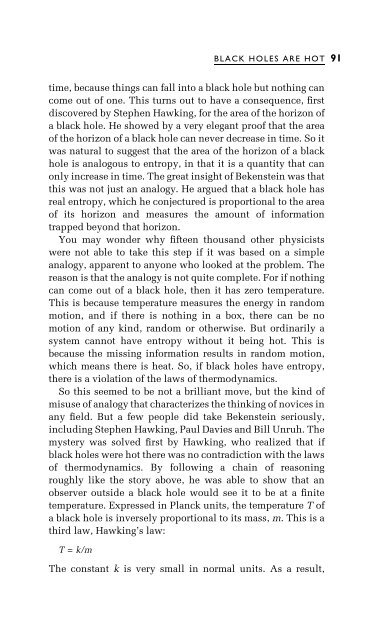Three Roads To Quantum Gravity
Three Roads To Quantum Gravity
Three Roads To Quantum Gravity
You also want an ePaper? Increase the reach of your titles
YUMPU automatically turns print PDFs into web optimized ePapers that Google loves.
BLACK HOLES ARE HOT<br />
91<br />
time, because things can fall into a black hole but nothing can<br />
come out of one. This turns out to have a consequence, ®rst<br />
discovered by Stephen Hawking, for the area of the horizon of<br />
a black hole. He showed by a very elegant proof that the area<br />
of the horizon of a black hole can never decrease in time. So it<br />
was natural to suggest that the area of the horizon of a black<br />
hole is analogous to entropy, in that it is a quantity that can<br />
only increase in time. The great insight of Bekenstein was that<br />
this was not just an analogy. He argued that a black hole has<br />
real entropy, which he conjectured is proportional to the area<br />
of its horizon and measures the amount of information<br />
trapped beyond that horizon.<br />
You may wonder why ®fteen thousand other physicists<br />
were not able to take this step if it was based on a simple<br />
analogy, apparent to anyone who looked at the problem. The<br />
reason is that the analogy is not quite complete. For if nothing<br />
can come out of a black hole, then it has zero temperature.<br />
This is because temperature measures the energy in random<br />
motion, and if there is nothing in a box, there can be no<br />
motion of any kind, random or otherwise. But ordinarily a<br />
system cannot have entropy without it being hot. This is<br />
because the missing information results in random motion,<br />
which means there is heat. So, if black holes have entropy,<br />
there is a violation of the laws of thermodynamics.<br />
So this seemed to be not a brilliant move, but the kind of<br />
misuse of analogy that characterizes the thinking of novices in<br />
any ®eld. But a few people did take Bekenstein seriously,<br />
including Stephen Hawking, Paul Davies and Bill Unruh. The<br />
mystery was solved ®rst by Hawking, who realized that if<br />
black holes were hot there was no contradiction with the laws<br />
of thermodynamics. By following a chain of reasoning<br />
roughly like the story above, he was able to show that an<br />
observer outside a black hole would see it to be at a ®nite<br />
temperature. Expressed in Planck units, the temperature T of<br />
a black hole is inversely proportional to its mass, m. This is a<br />
third law, Hawking's law:<br />
T = k/m<br />
The constant k is very small in normal units. As a result,



![arXiv:1001.0993v1 [hep-ph] 6 Jan 2010](https://img.yumpu.com/51282177/1/190x245/arxiv10010993v1-hep-ph-6-jan-2010.jpg?quality=85)


![arXiv:1008.3907v2 [astro-ph.CO] 1 Nov 2011](https://img.yumpu.com/48909562/1/190x245/arxiv10083907v2-astro-phco-1-nov-2011.jpg?quality=85)








![arXiv:1002.4928v1 [gr-qc] 26 Feb 2010](https://img.yumpu.com/41209516/1/190x245/arxiv10024928v1-gr-qc-26-feb-2010.jpg?quality=85)
![arXiv:1206.2653v1 [astro-ph.CO] 12 Jun 2012](https://img.yumpu.com/39510078/1/190x245/arxiv12062653v1-astro-phco-12-jun-2012.jpg?quality=85)
